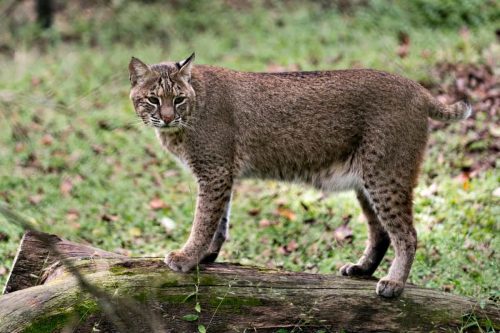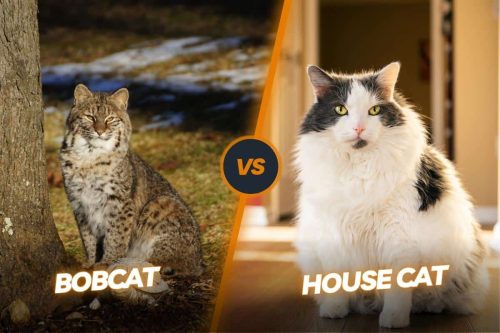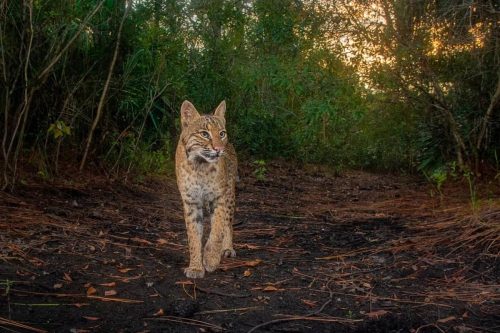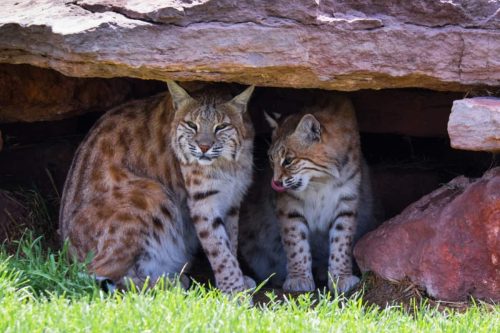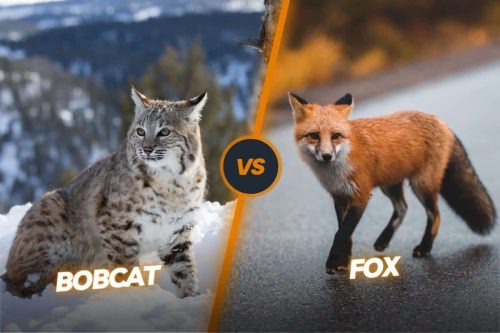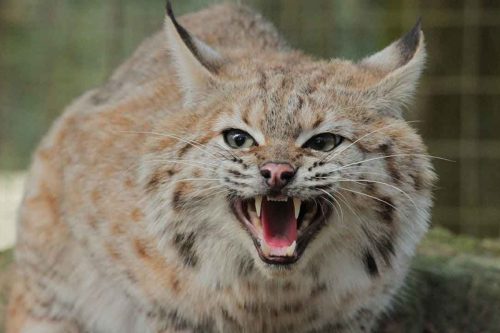Do Bobcats Have Tails: Unpacking The Mysteries Of Bobcat Tails
Bobcats are very well-known and big size wild cats. These cats are known for many things but the most distinguishable feature of the bobcat is its tail. Many people want to know do bobcats have tails. In this article, we are going to explain to you in detail all the aspects of the bobcat tail. Stay tuned.
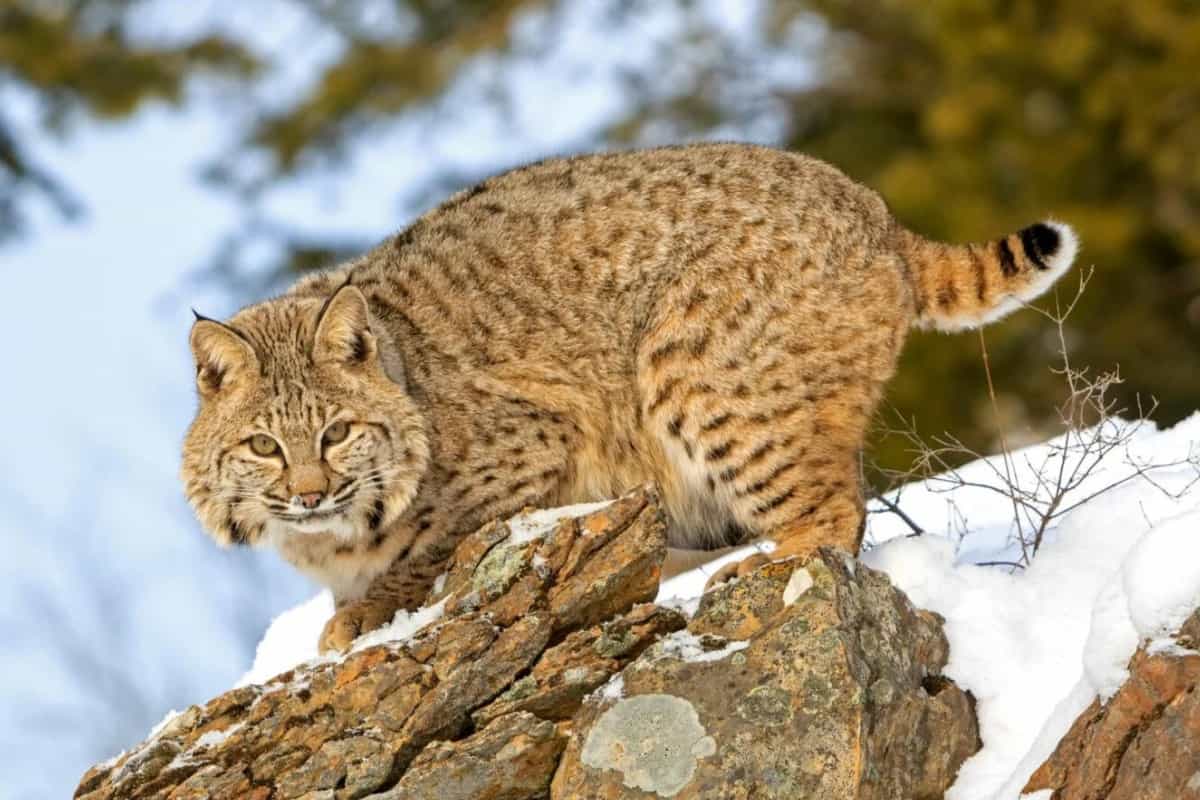
Contents
- Bobcat tails
- Do bobcats have tails?
- Bobcat tail length
- What do bobcat tails look like?
- Why do bobcats have short tails?
- Can bobcats have long tails?
- Do wild cats have long tails?
- Lynx vs bobcat tail
- What cat looks like a bobcat but has a long tail?
- The commercial importance of bobcat tail
- Frequently asked questions
- Conclusion
Bobcat tails
The name bobcat has a direct association with a bobbed-looking tail. This wild cat has actually been named based on their bobbed-shaped tail. Bobcat has a very short tail. It may be 5 or a maximum of 6 inches in length. A male bobcat has a slightly longer tail than a female bobcat.
Bobcats actually don’t need to have longer tails as they mainly reside in grounded areas like open fields, grasslands, deserts, or meadows. In these areas, they don’t need any kind of balance as the mountain lions need in mountainous regions. Thus, bobcats are fully functional even with short tails.
Do bobcats have tails?
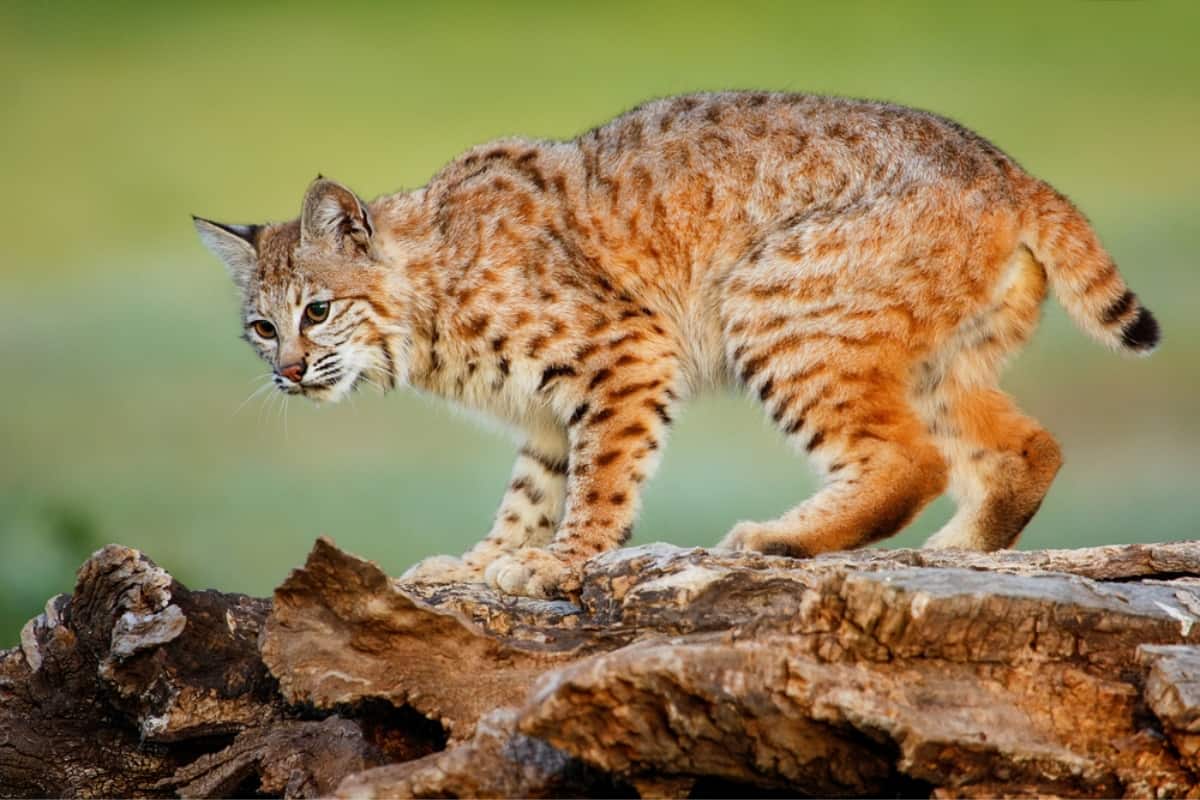
Yes, bobcats have tails but short ones. Many people are actually confused about the presence of a bobcat tail. They think the bobcat doesn’t come with an actual tail. We want to make it clear that bobcats have tails but they might not be long enough like other wild cats like mountain lions, tigers, and cougars.
On average, the size of the bobcat tail is almost 5 inches but it could also reach as long as 7 inches. However, it is a very rare case or almost impossible such as a long tail on a bobcat. It might happen in the case of any hybrid-type tail.
Bobcat tail length
Bobcat tail length varies according to their age. Baby bobcat has almost invisible and very short tail length. On average, it is just ¼ inches in length. When it comes to adult bobcat tail length then there is also variation in the length of male and female bobcats.
The average length of an adult female bobcat is 5 inches while the length of an adult male bobcat is 6 inches. Bobcats have very short tails as compared to other wild animals like tigers, mountain lions, cougars, etc. Some people have also seen bobcats with unusually long bobtails. It is very rare to see a bobcat with a tail length of 7 or 8 inches.
Otherwise, it could be other species like the Canadian lynx or Eurasian Lynx who also show a lot of physical similarities with the bobcats. Bobcats have short tails but these short tails even serve them very well as a balancing act for doing various kinds of activities.
What do bobcat tails look like?
As we have already mentioned, bobcats have very short tails. Let’s talk about their physical appearance. Bobcat tail actually has a mixture of colors. It has brown in color with dark color spots. It comes with tan fur in its surrounding. The inside color of the tail is white. With this mixture of colors, it is quite easy to identify the tail of the bobcat from other wild cats’ tails.
It is difficult to identify the bobcat litter from domestic cats from the look of their tail as they are not much different from each other. It only becomes identifiable when the cats grow old or their bobbed tail becomes more prevalent.
Why do bobcats have short tails?
The body of the bobcat has been designed by nature in such a way that it is perfect for their survival. The tail plays the main role in the balancing of animals. Bobcats don’t need much balancing as they don’t reside in mountainous areas or they don’t need a lot of climbing for their survival. They can easily hunt their prey without making any serious jumps.
It means there is not any serious need for a long tail in the bobcat routine life. It is okay if they have short tails. They come with very good body strength and retractable but very sharp claws which are good for hunting and long-term survival of their life.
Let’s have a look at some theories which explain in detail why do bobcats have short tails.
Ambush hunting
Bobcats like to catch their prey through ambush hunting. They hide in a spot until they reach very close to the prey and pounce on them and kill them with a striking blow. However, other wild cats like cheetahs chase their prey for some distance, and in this race, they use their tail for the speed advantage.
Leopards also like to ambush their prey but they mostly do it by climbing trees and the tail of the leopard is also helpful for balancing purposes. This suggests that the bobcats like to hunt on the ground by ambushing the prey and they don’t have to climb or run very fast for their prey. It means they don’t need to have a long tail.
Genetic mutation
It has also been observed by scientists that the short tail of the bobcat is actually a result of a genetic mutation in the bobcat’s anatomy. This change doesn’t impact their survival capabilities. It means there is no negative effect of genetic mutation on the survival of the bobcat. The short tail is also not a very negative thing from the survival point of view.
Thermoregulation
As you know the bobcat and other lynx species mainly reside in cold areas and they need to manage their body heat for their long-term survival. It means if you have a short body then there will be not a lot of heat transfer and you can easily manage your heat rather than having a very large body with a lot of heat transfer. It means a short tail is highly helpful in the thermoregulation of your body.
Can bobcats have long tails?
No, bobcats are not supposed to have long tails. There is some genetic mutation in the bobcat that doesn’t allow the length of the bobcat’s tail. This genetic mutation has been named as “bobcat gene”. However, once a bobcat was noted to have a very long tail of at least 9 inches but it is a very rare case.
Sometimes, people also mistake cougars for a bobcat due to their physical appearance. In this case, you might note other things but not the tail of a cougar as the tail of a bobcat. Cougar has a very long tail which could never be mistaken for the tail of a bobcat. The length of a cougar’s tail lies in the range between 2.5 to 3 feet in length.
Do wild cats have long tails?

Yes, many wild cats have long tails. However, the most prominent wild cat with a very long tail is a cougar or mountain lion. It is almost 2.5 to 3 feet long. It means it is almost 4 to 5 times longer than the tail of a bobcat. Other than long tails, these wild cats are also much bigger in size and weight.
These wild cats are very common in countries like Canada and USA. There are also many other wild cats with long tails like jaguars. These wild cats also mainly reside in North and South America. The population of the jaguar is gradually declining and these cats are among the endangered species.
These wild cats have very long tail which comes in the range between 1.5 to 3 feet long. These wild cat species are the largest and weigh around 300 pounds.
Lynx vs bobcat tail
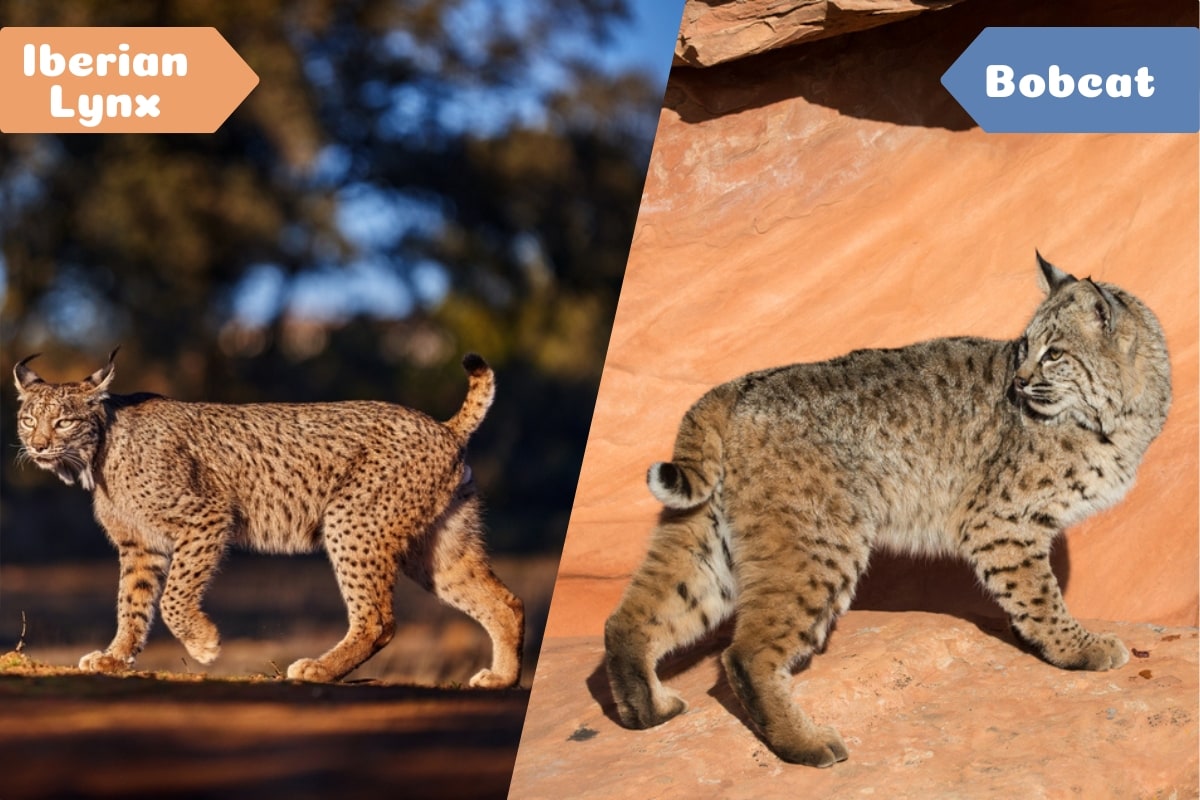
Bobcats belong to the lynx family but there are some differences between the bobcat and other lynx species. When it comes to tail, there is not any big difference between a bobcat and other lynx species. Generally, the Lynx family has very short tails. Canadian Lynx has a very short tail which is even shorter than the tail of a bobcat.
Canadian lynx has a very stubby tail that hardly reaches the length of 5 inches while the tail of bobcat sometimes reaches the length of 6 or 7 inches. Canadian lynx might have a shorter tail but it has very long legs and larger paws which are perfect for the snowy and cold habitat where they live.
There are also some other differences in their tails. Bobcat tail has a mixture of colors with a lot of spots and branding on them which you will not see in the tail of other lynx species. However, they have a common black tip on their tail.
Let’s have a look at a short overview of bobcat and lynx tails:
| Features | Bobcat | Canadian lynx | Eurasian lynx | Iberian lynx |
|---|---|---|---|---|
| Tail length | 3.5-8 inches | 1-5 inches | 4.5-9.5 inches | 5-12 inches |
| Tail Identification | Completely white inside with a black spot on the top plus stripes. | Short and fluffy with a black tip on the top. | Inside white with a black tip on the top. | Inside white plus spots on the upper side with a black tip on the top. |
What is the benefit of bobcats and lynx having short tails?
Both bobcat and lynx cats belong to the lynx genus group. The wild cats of this group have very short tails due to genetic mutation. These short tails don’t give any particular benefit to these wild cats but it also doesn’t hamper their survival. Normally, there are many benefits of long tails as it is highly helpful in balancing while climbing. That’s why snow leopards have very long tails. Bobcats and lynx mainly hunt on the ground level and they don’t need jumping or climbing for their survival.
The fluffy tails could also be used as a source of communication and for face-warming while sleeping. In this regard, both bobcats and lynxes have very large but soft coats as well as extra hairs on their legs for making themselves warmer while sleeping. A short bobtail would also reduce its body size or surface and resultantly it will lose less heat to the atmosphere.
Are lynxes and bobcats less agile than other cats with long tails?
No, there is no direct connection between agility and the length of the tail. A long tail might some role in the overall balancing of the wild cats but it doesn’t impact the agility of wild cats. Every wild cat has been naturally designed to deal with its own habitat.
Lynx have long legs, and powerful paws but short tails as they have to go through snowy areas but don’t need climbing or jumping for hunting their prey. Bobcats have slightly longer legs and also less powerful claws as they have to reside in open fields, grasslands, or forests.
What cat looks like a bobcat but has a long tail?
Bobcats are mainly shown resemblance with the lynx family and the lynx family members like Canadian, Eurasian, and Iberian all have very short tails like bobcats. However, there is one cat named caracal which has a lot of similarities with a bobcat like less weight, tuft ears, and a long tail. Nevertheless, these cats have longer legs than bobcats and come with tawny coat colors rather than banding or spotted bobcats.
The commercial importance of bobcat tail
There is a lot of commercial relevance to the bobcat tail. For commercial purposes, the bobcat tail is specially tanned and trimmed for crafts and fashion. Bobcats have very light and fluffy tails which lie in the range of 13 to 15 cm in length and almost 5 cm wide. These tails are mainly utilized as key chains.
Frequently asked questions
Conclusion
There is a lot of significance attached to the tail of any animal. The length of an animal’s tail deeply impacts its personality. The same is the case with bobcat tail. Bobcats have short tails which suit their personality and are equally good for their survival. We have tried our best to explain every aspect of the bobcat’s tail in detail by making its comparison with the tails of other animals. I hope this article helps you a lot in understanding the overall science of the bobcat tail.

Izzy is an experienced ranch worker who has a passion for exploring nature and getting up close to wildlife. With her connections to various animal organizations, Izzy is well-versed in animal care and rehabilitation.


